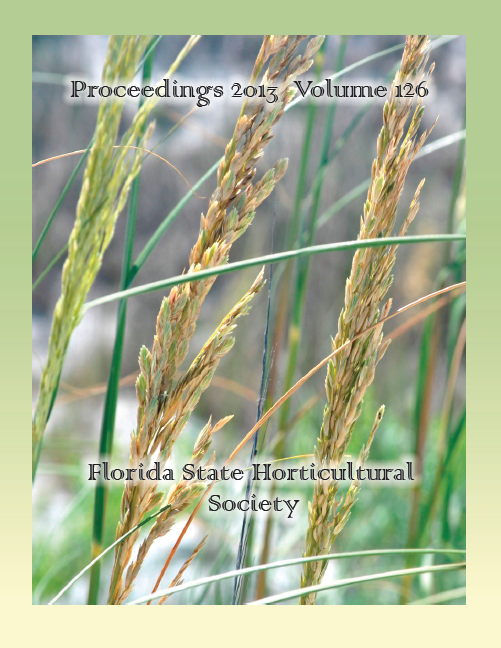Published 2013-12-01
Keywords
- Cucumis sativus,
- Meloidogyne,
- Vigna unguiculata,
- cover crop,
- cowpea
- cucumber,
- soil solarization ...More
Abstract
A study was conducted to address weed and root-knot nematode infestations in a commercial high tunnel in central Florida. A randomized complete-block design with four replications was used to test the effect of eight off-season treatments consisting of a weedy control, a weed-free treatment covered with black polyethylene film, and four cowpea cover crop treatments: ‘Iron Clay’, US-1136, US-1137, and US-1138 sown at 25 seeds/m2, all rototilled 8 weeks after seeding, a 9-week soil solarization treatment, and US-1137 cowpea grown for 4 weeks followed by 5 weeks of soil solarization. Soil solarization was terminated by removal of the solarization film. Solarized plots were not rototilled. Plots were mulched with white-on-black film (white side up) and 3-week-old cucumber (Cucumis sativus L. ‘Diva’) seedlings were transplanted into each plot on 3 Oct. The three recently released cowpea germplasm lines (US-1136, US-1137, and US-1138) did not differ significantly in biomass production from that of ‘Iron Clay’ cowpea. Grasses were the predominant weed species by mass, and all off-season fallow treatments resulted in significantly lower grass and total weed biomass than the weedy control. ‘Iron Clay’ cowpea was the only cover crop that resulted in greater marketable fruit number than the weedy fallow. Only US-1137 cowpea had a higher total marketable weight than the weedy fallow. Using US-1137 in combination with soil solarization did not significantly improve cucumber fruit weight over US-1137 alone. Significantly lower root-knot nematode populations in December after the cucumber crop (5 per 100 cm3) than in July (82 per 100 cm3) prior to the experiment could not be attributed to the off-season treatments. Additionally, root galling of cucumber with the alternative off-season treatments was not significantly different from that observed with the weedy control. Therefore, decreases in root-knot nematode galling were not the result of suppression of weeds with off-season cover crops and soil solarization. Earliness, extended production season, increased productivity, and reduced pest and disease pressure are some of the advantages of using high tunnels for crop production over open- field production (Lamont et al., 2003; Wells, 1996; Wells and Loy, 1993). Because of the season extension, high tunnels allow growers to offer a wider range of produce and obtain premium prices for produce that is in scarce supply during the winter. Although estimated to be only about 100 acres in 2009 (Carey et al.), high tunnel acreage in Florida has been growing rapidly and is currently estimated to be 1500 acres (Burfield, 2013).

